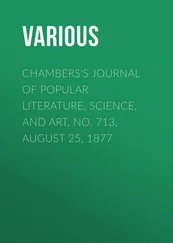Various - Chambers's Journal of Popular Literature, Science, and Art, No. 726
Здесь есть возможность читать онлайн «Various - Chambers's Journal of Popular Literature, Science, and Art, No. 726» — ознакомительный отрывок электронной книги совершенно бесплатно, а после прочтения отрывка купить полную версию. В некоторых случаях можно слушать аудио, скачать через торрент в формате fb2 и присутствует краткое содержание. Издательство: Иностранный паблик, Жанр: periodic, foreign_edu, на английском языке. Описание произведения, (предисловие) а так же отзывы посетителей доступны на портале библиотеки ЛибКат.
- Название:Chambers's Journal of Popular Literature, Science, and Art, No. 726
- Автор:
- Издательство:Иностранный паблик
- Жанр:
- Год:неизвестен
- ISBN:нет данных
- Рейтинг книги:3 / 5. Голосов: 1
-
Избранное:Добавить в избранное
- Отзывы:
-
Ваша оценка:
- 60
- 1
- 2
- 3
- 4
- 5
Chambers's Journal of Popular Literature, Science, and Art, No. 726: краткое содержание, описание и аннотация
Предлагаем к чтению аннотацию, описание, краткое содержание или предисловие (зависит от того, что написал сам автор книги «Chambers's Journal of Popular Literature, Science, and Art, No. 726»). Если вы не нашли необходимую информацию о книге — напишите в комментариях, мы постараемся отыскать её.
Chambers's Journal of Popular Literature, Science, and Art, No. 726 — читать онлайн ознакомительный отрывок
Ниже представлен текст книги, разбитый по страницам. Система сохранения места последней прочитанной страницы, позволяет с удобством читать онлайн бесплатно книгу «Chambers's Journal of Popular Literature, Science, and Art, No. 726», без необходимости каждый раз заново искать на чём Вы остановились. Поставьте закладку, и сможете в любой момент перейти на страницу, на которой закончили чтение.
Интервал:
Закладка:
Various
Chambers's Journal of Popular Literature, Science, and Art, No. 726 November 24, 1877
WAR AND TELEGRAPHY
It is vexing, even saddening, to think how large an amount of discovery, invention, and skill is applied to the murderous purposes of war. As we advance in civilisation, armies become larger and larger, and more abundantly supplied with agencies we would willingly see devoted to more peaceful purposes. Whether wars of race, wars of creed, wars of ambition, or wars of national vanity, the result is much about the same in this respect. Some consolers tell us that wars by-and-by will become so terrible as to check the desire to wage them: let us hope so, despite present symptoms.
Science has unquestionably rendered a vast amount of aid to attack and defence in war within the last few years. Gunpowder, gun-cotton, dynamite, and other explosive substances for fire-arms, torpedoes, and military mining have had their properties and relative powers investigated with remarkable completeness. Gun-carriages have been so vastly improved, that by Captain Scott's contrivances a six-hundred-pounder can be managed as easily and quickly as a thirty-two-pounder could in the days of our fathers or grandfathers; while by Major Moncrieff's automatic apparatus a gun lowers itself behind the screen of a parapet or earthen battery for loading, and then raises itself twelve or fifteen feet to fire over it.
Photography, again, is applied in a great variety of ways to aid warlike operations. At the office of the Ordnance Survey, or under the supervision of the Director, an amazing number of such photographs are taken, enlarged or reduced from the original dimensions according to circumstances, and multiplied or prepared for printing by a very rapid process of zincography or some other kind of electro-engraving. One of the Reports issued by the Director tells us that he supplies the War Office with photographs of plans of battles, important fortified posts and their surrounding districts, barracks and forts in all parts of the British dominions, &c. All the equipments of troops for the field are similarly photographed or zincographed, as unerring patterns for reference. For such wars as we have been engaged in during the past five-and-twenty years (happily few in number), such as the Crimean, Abyssinian, and Ashanti campaigns, photographs and zincographs have been supplied in large number to the officers, illustrating all details which the home authorities have been able to ascertain, and which are likely to be useful in the intended operations.
What are we to say of the torpedo , and its management by electricity? This is really a wonderful subject, the influence of which on future naval warfare even the most skilled and experienced officers can only dimly surmise. We know that during the civil war in America, the Federal torpedoes wrought more destruction on the Confederate ships than all the guns in the Federal fleet; that, on the other hand, the Confederate torpedoes so effectually guarded the approach to Richmond up James River, that a hostile flotilla was compelled to retire baffled and disappointed. One unlucky Federal ship unwittingly passed over a submerged torpedo at the moment of explosion. And with what result? 'The hull of the ship was visibly lifted out of the water, the boiler exploded, the smoke-funnels were carried away, and the crew projected into the air with extreme velocity. Out of the crew of one hundred and twenty-seven men, only three remained alive – the vessel itself being blown to atoms.' The arrangements have been so much improved since that time, that messages can be sent across a river or estuary from shore to shore through the very wire which is to discharge the torpedo! In every naval war during the last few years, torpedoes have been more or less employed. In what way the weaker Russian fleet has been able to baffle the stronger fleet of the Turks in the struggle of 1877, the newspapers have told us in full detail. There is no necessity for pursuing this part of the subject further, seeing that it was lately treated with some degree of fullness in our pages.
But the greatest marvel of all, in regard to the application of electricity to warlike purposes, is the electric telegraph . We know what service the lightning-messenger renders to society generally in the peaceful daily maintenance of commercial and social intercommunication; and military men now know what a potent instrument it is in the conduct of field-operations and siege-works. An officer well qualified to judge affirms that the memorable Franco-German War, so disastrous to France, could not have been carried on without the aid of the electric telegraph by the German forces. The warlike struggles engaged in by various European powers in the Crimea, in India during the Mutiny, in China, in New Zealand, in the Austro-Italian provinces, in Morocco by the Spaniards, in America by the Federals and the Confederates, in Holstein during the brief Dano-German War, in Bohemia during the still briefer Austro-Prussian War, in Abyssinia, in France during the struggle against the Germans, in Ashanti – all these were marked by the adoption of the electric telegraph to a greater or less extent.
Many of us remember, from the vivid descriptions written by the special correspondents of the daily newspapers, how terrible were the sufferings of the British troops in the Crimea during the winter of 1854-5, engaged in trench-work and other siege-operations under almost every kind of privation. But we also know how impossible it would have been to learn the news quickly in England and to send instructions, without the aid of telegraphy. An electric cable was for this very purpose submerged in the Black Sea from the Turkish mainland to the Crimea; while on land, wires were set up from Balaklava to the headquarters outside Sebastopol. Thus it was that daily messages could be exchanged between Lord Raglan's headquarters and the War Office in London – also between the special correspondents of the daily papers and their employers in Fleet Street or Printing House Square. So in like manner, during the struggle arising out of the Indian Mutiny, the advancing British columns contrived, wherever possible, to maintain unbroken telegraphic communication with Calcutta, whereby the viceroy was kept informed of what was going on. Of course the mutineers or rebels destroyed or disrupted the wires wherever and whenever they could; and to repair the damage thus inflicted formed no small part of the arduous duties of the British officers.
Our little but expensive war in Abyssinia in 1868, marked by a less shedding of blood than almost any other war in modern times, was an engineers' war from first to last. A wild and unknown country was surveyed and accurately mapped out, four hundred miles of road constructed, tube-wells sunk, photographs of various useful kinds taken, and a telegraphic system established. The telegraphic arrangements first made had to be abandoned, owing to the scantiness of the facilities for transporting the necessary materials. The more restricted plan actually adopted was difficult enough, so limited were the means of obtaining wood for telegraph poles. On approaching Magdala, however, Captain St John (who had the management of this part of the engineering) succeeded in laying down from five to ten miles a day. Short as was the war, this telegraph conveyed more than seven thousand eight hundred messages during the five months of its working, and aided most materially in giving effect to General (now Lord) Napier's well-planned and successful scheme of operations.
Our strange Ashanti War gave further evidence of the formation of a telegraph line through a wild country inhabited by a barbarous people. Lieutenant Jekyll, who had the management of this work, has given a lively account of the difficulties that beset him, and his mode of overcoming them. It was at first intended to fight the war with native levies and to lay down a railway; but Sir Garnet Wolseley, on landing to take the command, soon found that the natives were not sufficiently reliable, that the country was almost impracticable for a railway, that he must have English troops, and that an electric telegraph would be a highly useful aid. Lieutenant Jekyll, with a small staff, went inland and bought bamboo canes of the blacks, set them up as posts, and laid his wires from Cape Coast Castle to Coomassie at the rate of about two miles a day. A gang of fifty natives helped him. Of these worthies he says: 'They were not promising in appearance, and I was compelled to dispense with the services of those who were
Читать дальшеИнтервал:
Закладка:
Похожие книги на «Chambers's Journal of Popular Literature, Science, and Art, No. 726»
Представляем Вашему вниманию похожие книги на «Chambers's Journal of Popular Literature, Science, and Art, No. 726» списком для выбора. Мы отобрали схожую по названию и смыслу литературу в надежде предоставить читателям больше вариантов отыскать новые, интересные, ещё непрочитанные произведения.
Обсуждение, отзывы о книге «Chambers's Journal of Popular Literature, Science, and Art, No. 726» и просто собственные мнения читателей. Оставьте ваши комментарии, напишите, что Вы думаете о произведении, его смысле или главных героях. Укажите что конкретно понравилось, а что нет, и почему Вы так считаете.







